Math in Informal Spaces Transcript
Dolores Torres: My name is Dolores Torres. I am a preschool teacher at the [Linnux 00:00:08] Day Preschool at Buford Site.
Hi, Arabella. How are you? [foreign language 00:00:12] Good morning. [foreign language 00:00:15] Good morning.
Today in the classroom, we're going to focus on informal math teaching during breakfast, large group, and work time.
How many slices of apple do you have here? [crosstalk 00:00:34] Do you want to count your slice of apples? Thank you so much.
Speaker 2: One, two, three, four, five, six.
Dolores Torres: Six. So if you eat one, how many are you going to have?
Speaker 2: One.
Dolores Torres: Okay, so if you're eating that one ... We counted apples slices that they had in their package. We did a little bit of pre thinking, which is how many do you think are in the package?
Why do you think there's five slices? Okay, I want you to count them for me, okay? Now you touch them and you count. Ready?
Speaker 2: One, two, three, four, five.
Dolores Torres: How many? Five slices.
Children also counted how many were left after they ate some.
How many are in the package now?
[foreign language 00:01:22]
Oh no, how many are in the package now? Zero, and zero means? What does zero mean?
Speaker 2: Nothing.
Dolores Torres: Nothing. Nada.
I think they do notice, for example, if it's something that we have for breakfast, then they'll say like, "She has more or I have less," or, "I already ate this many so she has more than me now." Things like that, so they're always noticing, especially quantities, when it's breakfast.
All right Ruby, what do you want to tell them? Okay boys and girls, it's cleanup time please.
They're dismissed for breakfast. We clean up and they go to wash their hands and we have the timers there. As they wash their hands, they do their own counting on their own.
[crosstalk 00:02:13]
Very good, remember keep counting until you hear the timer. What's after 20?
Speaker 2: 24, 25.
Dolores Torres: I've noticed a growth in the children with their own counting, they're more aware of if they're missing a number or if, for example, they're not following the correct order of it. It has progressed a lot. The children are now able to count past 20 in less than 20 seconds.
You think there's 11 flowers?
After they finish washing their hands, they sit at the carpet and they get to choose whatever book they have. We were reading, Planting a Rainbow. We were focusing on the page where it had flowers that had already bloomed but then it had buds. So first we counted the flowers that had already bloomed and then if these buds bloom, then how many flowers will we have?
One, two, three, four, five, six, seven, eight, nine, ten, eleven. How many flowers are we going to have?
Speaker 2: 11.
Dolores Torres: 11, after everything blooms. Okay boys and girls, let's put the books away, books away. They got to choose today what insect do they prefer.
Which insect do you prefer, a butterfly or a ...
Speaker 2: Preying mantis.
Dolores Torres: Preying mantis? Everybody stand up. Stand up. Okay Anthony, make a decision, which insect do you prefer?
Once everybody chose the insect that they preferred, we counted how many children preferred the butterfly, how many children preferred the preying mantis.
[crosstalk 00:03:55]
How many? 10. Anthony do you want to go find the number 10?
Anthony: Okay.
Dolores Torres: Good.
We had an even number of children that chose the butterfly and preying mantis, and then we went into asking, "What if"? If I change Ruby's name ... to the butterfly, to the butterfly side, which one would have more?
[crosstalk 00:04:20]
What is it Robert?
Robert: It has 11.
Dolores Torres: Oh now it has 11. Is 11 more or less than 10?
I said, "Okay, what if one more student chose to change their minds?" Then we did it again, and then somebody said, "Well now we would have 13." It creates that opportunity for them to problem solve and see what if this happens. It's important to just expose them and get their brain started and all those things because they catch it.
Stand up, go chose a center. Go have fun.
When we were done with large group, children went into work time.
Do you want to work with us Ruby?
We have different centers around the classroom and then they play wherever they want to.
Speaker 5: There's a spider on your head.
Dolores Torres: Oh, no thank you.
Since our theme is insects, we talked about the amount of legs that they have, the different body parts that they have.
Let's count the legs on the arachnid.
Speaker 2: One, two, three, four, five, six, seven, eight.
Dolores Torres: Eight, so what is the difference?
Speaker 2: Eight.
Dolores Torres: This one has how many legs?
Speaker 2: Eight.
Dolores Torres: Eight, and this one?
Speaker 2: Six.
Dolores Torres: Six. So is this an insect?
Speaker 2: Yes. Arachnid.
Dolores Torres: It's an arachnid, right? [foreign language 00:05:35]
William was working at the large carpet with the wedges and he was really excited. I asked him to describe what he had been doing.
You made a tower? William, [foreign language 00:05:50]. Oh wow, William. [foreign language 00:05:55]
I took the opportunity to focus more on sizes than quantities because the wedges do create that opportunity for us.
Why doesn't it fit now?
We talked about sizes and why doesn't this one fit, and what are we going to do? They started saying, "Because this is the same size, so this one doesn't fit."
So do we need a bigger one or a smaller one?
[crosstalk 00:06:23]
The smaller one, yes you're right.
William: This goes right here. It goes right here.
Dolores Torres: Why? Why does this one go right here?
William put one on top and then it fell down, and then he kept trying and kept trying. Then I capitalized on that opportunity and I asked, "Why isn't it staying? Why does it keep falling?"
Hi Samantha. Hi. Can I play with you?
I walked over to the back of the classroom and at the carpet, Samantha was working with the magnet tiles.
What are you building? Tell me, what is it?
Samantha: I'm building a house.
Dolores Torres: You're building a house. Are you going to build the house vertically?
Samantha: Yeah.
Dolores Torres: Yes. Oh my goodness.
I did do the hand gestures so that she could see that vertically is going up and down.
Do you want to ask Samantha if you can work with her?
Priscilla: Yes.
Dolores Torres: Then Priscilla came in and joined us.
Who's smaller, the house, Samantha, or Priscilla?
Priscilla: Samantha.
Dolores Torres: Samantha's smaller? Who's smaller than Samantha?
Samantha: I'm smaller.
Dolores Torres: I know. Is the house smaller or taller than Samantha?
Priscilla: [inaudible 00:07:33]
Dolores Torres: It's smaller, right?
The problem happened that they ran out of squares.
Priscilla: We don't have anymore of the ...
Dolores Torres: Of what?
Priscilla: Squares.
Dolores Torres: We don't have anymore? How can we create a square if we don't have anymore?
But then Samantha went over and she grabbed two small sized triangles and she put them together.
Samantha: Oh yeah, [inaudible 00:07:54].
Dolores Torres: Oh, look. Look at what Samantha did.
Priscilla: That's a diamond.
Dolores Torres: It is but look at what happens when I turn it like this. What does it look like?
Priscilla: A square.
Dolores Torres: A square so what shapes did Samantha use?
I moved it over and she said, "Oh, now it looks like a square."
What did you do with the triangles to make a square?
Samantha: Put them together.
Dolores Torres: They have the opportunity to use those every day and on their own. They're able to just capitalize and problem solve. If something doesn't work, then they get the opportunity to build again.
Yes, you know what? We're going to get ready to go outside.
Group: Yay!
Dolores Torres: I think overall, we were able to cover a lot of aspects of math: patterns, quantities, shapes. We did special relations. Opportunities are endless when it comes to math. I feel like it's very important to see math as a regular other subject, not a scary as we think it is. It's fun.

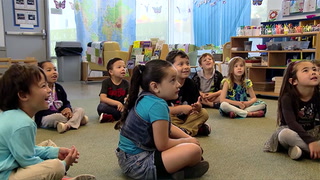

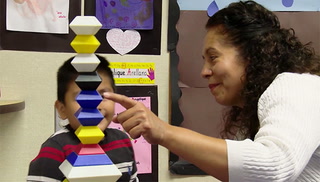
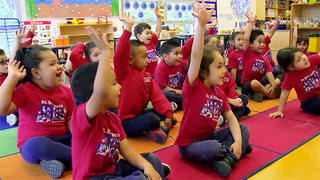

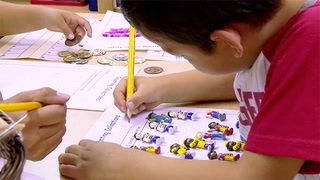
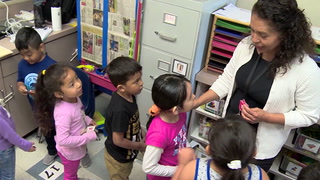
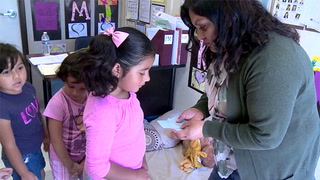
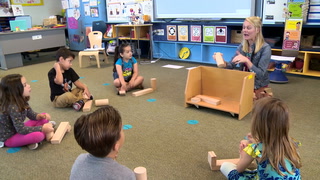


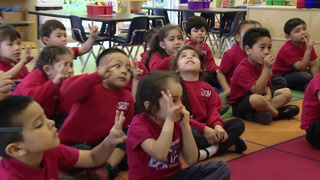









4 Comments
Avery Baird May 16, 2020 10:05pm
I really liked how this teacher took an everyday routine and made it interactive with the kids while asking them math questions to get their minds going for the day. I also like that this way of teaching allows them to be constantly looking around and using their quantity skills to notice if other students have more or less than them. I loved the third activity and how the students were engaged with each other and how they students were allowed to choose the insect they wanted and this allows them to make their own choices, then, later on, use mathematical skills to add up how many of each. I also liked how she took the initiative to ask students questions about sizes and shapes rather than just quantities.
Janice Roberts May 19, 2018 9:04pm
Rosemarie McFat... Jan 31, 2018 1:08pm
Christian Lopez Jan 27, 2018 1:46am